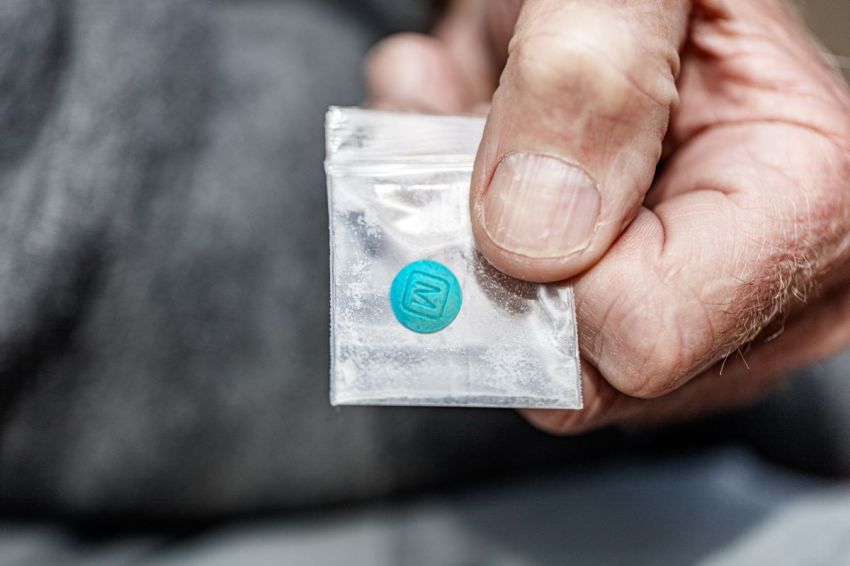Most American voters don't know fentanyl is killing over 50,000 Americans a year: poll

While an overwhelming share of American voters believe the rising trend of overdoses from the opioid drug fentanyl is a serious issue and becoming a bigger problem, a new poll suggests nearly two-thirds don't know the scale of the problem in the United States.
A national survey of 1,000 likely U.S. voters conducted by Pulse Opinion Research, LLC for Rasmussen Reports from Sept. 26 to Sept. 27 by phone and finds that 91% of participants believe the country's fentanyl issue is serious, with 73% describing it as a "very serious problem."
The poll's margin of sampling error is +/- 3 percentage points with a 95% confidence level.
The U.S. Centers for Disease Control and Prevention reports that overdose deaths from opioids increased from over 70,000 in 2020 to over 80,000 in 2021. Over 71,000 of those 2021 opioid deaths came from overdoses on synthetic fentanyl, up from around 57,000 in 2020.
But fewer than a third of voters surveyed (31%) correctly responded that fentanyl killed more than 50,000 Americans in 2021.
Eighteen percent believe that fentanyl overdoses killed between 20,000 and 50,000, and 17% think the drug killed 10,000 and 20,000.
Seventy-two percent of respondents say the fentanyl problem has worsened over the past two years, 12% think it's the same, and 8% believe the issue has improved. Twenty-nine percent of voters are unsure.
When broken down by political parties, 36% of voters trust Republicans to deal with the problem, compared to 32% who trust Democrats on the issue. Another 28% don't see any difference between either party's ability to resolve the issue.
"President Joe Biden's strongest supporters are least likely to think America's fentanyl problem has gotten worse," the report states. "Among voters who Strongly Approve of Biden's job performance as president, 48% believe the fentanyl problem has gotten worse in the past two years. By contrast, among those who Strongly Disapprove of Biden's performance, 88% say America's fentanyl problem has gotten worse since 2020."
The CDC warns that fentanyl is exponentially more potent than heroin and morphine and that ingesting just two milligrams can be deadly. Fentanyl overdose is the leading cause of death among U.S. adults ages 18-45, according to analysis of CDC data.
Last month, the U.S. Drug Enforcement Agency warned that drug traffickers have begun adding candy-colored codings to fentanyl pills that could attract children, known as rainbow fentanyl.
The agency seized brightly colored fentanyl pills across 18 states, calling it "a new method used by drug cartels to sell highly addictive and potentially deadly fentanyl made to look like candy to children and young people."
"Rainbow fentanyl — fentanyl pills and powder that come in a variety of bright colors, shapes, and sizes — is a deliberate effort by drug traffickers to drive addiction amongst kids and young adults," said DEA Administrator Anne Milgram.
"The men and women of the DEA are relentlessly working to stop the trafficking of rainbow fentanyl and defeat the Mexican drug cartels that are responsible for the vast majority of the fentanyl that is being trafficked in the United States."
As teens are receiving prescription drugs from people they meet through social media, they may not even know they are taking fentanyl before it's too late. That appears to be the case for 17-year-old California teen Zach Didier, who died of opioid poisoning in December 2020.
On Dec. 27, 2020, Chris Didier entered his son's room and found him slumped over his desk as if he were sleeping. In a June statement to Fox News, the father said he knew something was "horribly wrong," recalling how he felt "something dark and something empty."
A former US military service member, Didier attempted to use his CPR training to revive his son. Medics arrived to take over, but after 10 minutes, there was nothing more they could do for the teenager.
Coroners informed the parents that their son either died from natural causes or from taking fentanyl. Chris Didier and his wife, Laura, were confused about how their son obtained such a drug. They later learned that he bought what he thought was a Percocet pill from someone on Snapchat.
According to WebMD, Percocet is a combination medication used to relieve pain that contains an opioid pain reliever, oxycodone, and a non-opioid pain reliever, acetaminophen. Instead of Percocet, however, Zach Didier received a counterfeit pill made up of fentanyl.
"All the other parents that we knew, all of his soccer team, all of those friends — none of us had ever heard of a counterfeit prescription pill that had only fentanyl in it as the acting agent," Chris Didier said.
"I also learned that social media is a very common platform. You can get whatever you want on social media at any age, and I had no idea that that was going on."
A study published in April by the Journal of the American Medical Association (JAMA) and analyzed by Science Daily found the rate of overdose deaths among US teenagers doubled in 2020 and rose another 20% in the first half of 2021.
"[Researchers] found 518 deaths, or a rate of 2.4 per 100,000, among adolescents in 2010, and a steady rate of 492 deaths (2.36 per 100,000) each subsequent year through 2019. In 2020, there was a sharp increase to 954 deaths (4.57 per 100,000), rising to 1,146 deaths (5.49 per 100,000) in early 2021," Science Daily reported.
The study's lead author, addiction researcher Joseph Friedman, noted fake versions of prescriptions such as Xanax, Percocet, and Vicodin, all of which can vary in terms of strength, have contributed to the increase in overdose deaths.
"Teens urgently need to be informed about this rising danger," Friedman said. "Accurate information about the risk of drugs needs to be presented in schools. Teens need to know that pills and powders are the highest risk for overdose, as they are most likely to contain illicit fentanyls. Pills and powders can be tested for the presence of fentanyls using testing strips, which are becoming more widely available."
Families Against Fentanyl, an organization that raises awareness about the drug's "toxicity" and "accessibility," reported in an analysis last year of government data that nearly 79,000 people between the ages of 18 and 45 died of fentanyl overdoses between April 2020 and April 2021.
A fact sheet no longer available on the Families Against Fentanyl website described how illicitly manufactured fentanyl and fentanyl analogs, or IMFs, are present in most street drugs.
James Rauh, the organization's founder who lost a son to an overdose, called the issue a "national emergency" in a statement last December to Fox News.
"America's young adults — thousands of unsuspecting Americans — are being poisoned," he said. "It is widely known that illicit fentanyl is driving the massive spike in drug-related deaths. A new approach to this catastrophe is needed."



























